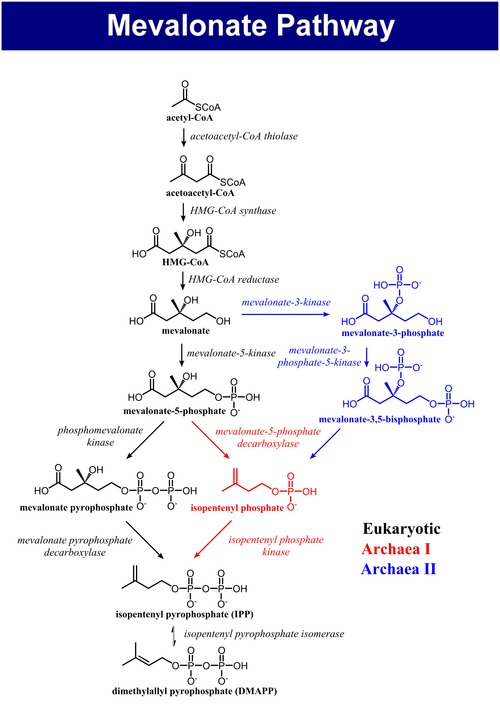


The mevalonate pathway, also known as the isoprenoid pathwayorHMG-CoA reductase pathway is an essential metabolic pathway present in eukaryotes, archaea, and some bacteria.[1] The pathway produces two five-carbon building blocks called isopentenyl pyrophosphate (IPP) and dimethylallyl pyrophosphate (DMAPP), which are used to make isoprenoids, a diverse class of over 30,000 biomolecules such as cholesterol, vitamin K, coenzyme Q10, and all steroid hormones.[2]
The mevalonate pathway begins with acetyl-CoA and ends with the production of IPP and DMAPP.[3] It is best known as the target of statins, a class of cholesterol lowering drugs. Statins inhibit HMG-CoA reductase within the mevalonate pathway.
The mevalonate pathway of eukaryotes, archaea, and eubacteria all begin the same way. The sole carbon feed stock of the pathway is acetyl-CoA. The first step condenses two acetyl-CoA molecules to yield acetoacetyl-CoA. This is followed by a second condensation to form HMG-CoA (3-hydroxy-3- methyl-glutaryl-CoA). Reduction of HMG-CoA yields (R)-mevalonate. These first 3 enzymatic steps are called the upper mevalonate pathway.[4]
The lower mevalonate pathway which converts (R)-mevalonate into IPP and DMAPP has 3 variants. In eukaryotes, mevalonate is phosphorylated twice in the 5-OH position, then decarboxylated to yield IPP.[4] In some archaea such as Haloferax volcanii, mevalonate is phosphorylated once in the 5-OH position, decarboxylated to yield isopentenyl phosphate (IP), and finally phosphorylated again to yield IPP (Archaeal Mevalonate Pathway I).[5] A third mevalonate pathway variant found in Thermoplasma acidophilum, phosphorylates mevalonate at the 3-OH position followed by phosphorylation at the 5-OH position. The resulting metabolite, mevalonate-3,5-bisphosphate, is decarboxylated to IP, and finally phosphorylated to yield IPP (Archaeal Mevalonate Pathway II).[6][7]
Several key enzymes can be activated through DNA transcriptional regulation on activation of SREBP (sterol regulatory element-binding protein-1 and -2). This intracellular sensor detects low cholesterol levels and stimulates endogenous production by the HMG-CoA reductase pathway, as well as increasing lipoprotein uptake by up-regulating the LDL-receptor. Regulation of this pathway is also achieved by controlling the rate of translation of the mRNA, degradation of reductase and phosphorylation.[1]
A number of drugs target the mevalonate pathway:
A number of diseases affect the mevalonate pathway:
Plants, most bacteria, and some protozoa such as malaria parasites have the ability to produce isoprenoids using an alternative pathway called the methylerythritol phosphate (MEP)ornon-mevalonate pathway.[9] The output of both the mevalonate pathway and the MEP pathway are the same, IPP and DMAPP, however the enzymatic reactions to convert acetyl-CoA into IPP are entirely different. Interaction between the two metabolic pathways can be studied by using 13C-glucose isotopomers.[10] In higher plants, the MEP pathway operates in plastids while the mevalonate pathway operates in the cytosol.[9] Examples of bacteria that contain the MEP pathway include Escherichia coli and pathogens such as Mycobacterium tuberculosis.
| Enzyme | Reaction | Description |
| Acetoacetyl-CoA thiolase |  |
Acetyl-CoA (citric acid cycle) undergoes condensation with another acetyl-CoA molecule to form acetoacetyl-CoA |
| HMG-CoA synthase | Acetoacetyl-CoA condenses with another Acetyl-CoA molecule to form 3-hydroxy-3-methylglutaryl-CoA (HMG-CoA). | |
| HMG-CoA reductase |  |
HMG-CoA is reduced to mevalonatebyNADPH. This is the rate limiting step in cholesterol synthesis, which is why this enzyme is a good target for pharmaceuticals (statins). |
| mevalonate-5-kinase |  |
Mevalonate is phosphorylated at the 5-OH position to yield mevalonate-5-phosphate (also called phosphomevalonic acid). |
| mevalonate-3-kinase |  |
Mevalonate is phosphorylated at the 3-OH position to yield mevalonate-3-phosphate. 1 ATP is consumed. |
| mevalonate-3-phosphate-5-kinase |  |
Mevalonate-3-phosphate is phosphorylated at the 5-OH position to yield mevalonate-5-phosphate (also called phosphomevalonic acid). 1 ATP is consumed. |
| phosphomevalonate kinase |  |
mevalonate-5-phosphate is phosphorylated to yield mevalonate-5-pyrophosphate. 1 ATP is consumed. |
| mevalonate-5-pyrophosphate decarboxylase |  |
Mevalonate-5-pyrophosphate is decarboxylated to yield isopentenyl pyrophosphate (IPP). 1 ATP is consumed. |
| isopentenyl pyrophosphate isomerase |  |
isopentenyl pyrophosphateisisomerizedtodimethylallyl pyrophosphate. |
|
| |||||||||||||
|---|---|---|---|---|---|---|---|---|---|---|---|---|---|
| Mevalonate pathway |
| ||||||||||||
| Tocholesterol |
| ||||||||||||
| ToBile acids |
| ||||||||||||
| Steroidogenesis |
| ||||||||||||
|
Metabolism map
| ||
|---|---|---|
Single lines: pathways common to most lifeforms. Double lines: pathways not in humans (occurs in e.g. plants, fungi, prokaryotes). | ||